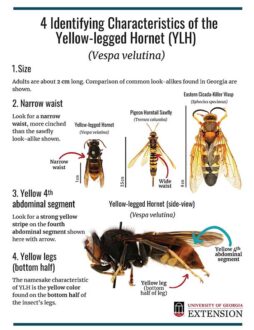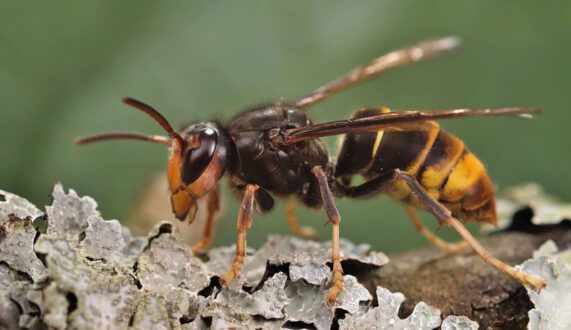Sep 25, 2023Georgia destroys bee predator hornet nest
To protect the state’s honeybee population, Georgia agricultural officials have detected and destroyed the nest of a yellow-legged hornet’s nest.
The yellow-legged hornet feeds on a variety of insects, including honeybees. If allowed to establish in the U.S., the invasive pest could threaten domestic and feral honey bees as well as native pollinators and disrupt the pollination of many crops as well as endangered populations of native bees that are already decimated for multiple reasons, according to the U.S. Department of Agriculture (USDA).
The hornet was discovered on Wilmington Island near Savannah, Georgia. Georgia workers worked in coordination with the USDA and the University of Georgia (UGA) in the discovery and destruction of the nest, which was the second one detected, according to a news release from Georgia Agriculture Commissioner Tyler Harper.


The first live detection of a yellow-legged hornet (YLH: Vespa velutina) in the open U.S. was confirmed in Georgia on Aug. 9. On Aug. 23, a yellow-legged hornet’s nest was located and destroyed by GDA staff and pest management professionals in a residential neighborhood on Wilmington Island.
“Since the initial detection of the yellow- legged hornet in Georgia, the Department’s team of dedicated professionals have been working overtime to find any additional yellow-legged hornets in our state, and thanks to their tireless work, we have eradicated a second yellow-legged hornet’s nest,” Harper said in the release. “While this eradication is a win for our state and our agriculture industry, we’ll continue working around the clock to find any additional hornets, eradicate this invasive pest, and protect our state’s agriculture industry. The public has played a vital role in this effort, and we’re asking Georgians to continue reporting any suspected sightings directly to the Department.”
The second nest was discovered by GDA staff under a bridge on Wilmington Island on Sept. 15 and was eradicated that evening by the same crew of pest management professionals who assisted with the eradication of the first nest. The nest was located using a variety of techniques, including capturing, marking and releasing hornets to estimate the distance from the trapping location to the nest.
Additionally, hornets were captured, taken to different locations, and released so their flight direction could be observed. As this process was repeated, the size of the search area was gradually reduced until the nest was located.
After eradication, the nest was examined by Dr. Lewis Bartlett from the University of Georgia and Dr. Jamie Ellis from the University of Florida. They identified developing hornets within the nest and confirmed there was no evidence of the production of reproductive males or queens within the colony at the time of destruction. Additionally, UGA scientists sequenced the genetics of hornets from the first nest and evidence suggests the hornets originated in Asia. DNA samples were taken from the second nest, and genetic analysis of these samples is ongoing.
“The University of Georgia remains committed, alongside our colleagues at the Georgia Department of Agriculture, to the task of eradicating the yellow legged hornet from Georgia and the rest of the country,” Keith Delaplane, UGA professor of entomology and Honey Bee Program Director, said in the release. “While it does not pose a serious risk to humans, pets and livestock, this hornet has proven itself a deadly predator of honey bees and other pollinators in Europe and Asia. An ideal scenario would be the discovery and eradication of every established nest before the colonies have time to issue new queens who overwinter and start the life cycle over again next spring.”
The Department has two teams of four deployed in the Savannah area that are actively trapping and surveying for additional nests, and these teams have placed 134 traps in the area around the initial detection. So far, confirmed detections of the yellow-legged hornet have been made in 12 locations around Wilmington Island, Whitemarsh Island and Thunderbolt, Georgia. Nine of these detections were reported to the department by citizens and three were captured in traps set by GDA staff. GDA continues to explore options to more efficiently and effectively trap and track the yellow-legged hornet and recently received electronic monitoring equipment from the Washington Department of Agriculture, which will be put into use in the coming days, according to the release.
Top photo: Georgia ag officials have eradicated the nest of a yellow-legged hornet, an invasive species that threatens honeybees. Photo courtesy of USDA.















